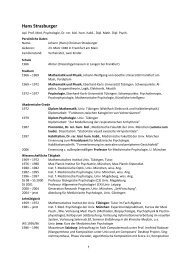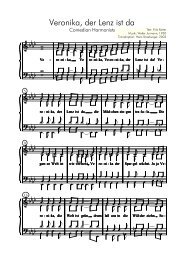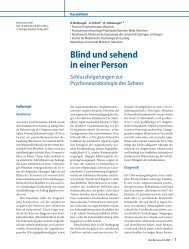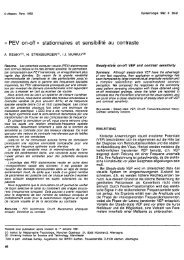Peripheral vision and pattern recognition: a review - strasburger - main
Peripheral vision and pattern recognition: a review - strasburger - main
Peripheral vision and pattern recognition: a review - strasburger - main
You also want an ePaper? Increase the reach of your titles
YUMPU automatically turns print PDFs into web optimized ePapers that Google loves.
<strong>Peripheral</strong>_Vision.doc<br />
High contrast character <strong>recognition</strong> <strong>and</strong> acuity in eccentric <strong>vision</strong> are crucially affected by the<br />
deployment of spatial attention (Nakayama & Mackeben, 1989; Mackeben, 1999; Carrasco et<br />
al., 2002; Talgar et al., 2004). Results depend on whether the subject knows where to expect<br />
the stimulus, <strong>and</strong> whether <strong>and</strong> when there are spatial cues marking the target location. These<br />
dependencies have been known since long (cf. Chapter 2); to eliminate that influence in acuity<br />
measurement, researchers typically have chosen paradigms where the subject knows the<br />
eccentric location. However, sustained attention has been shown to be anisotropic with a<br />
dominance of the horizontal meridian in the macula (Mackeben, 1999). Performance at<br />
disfavored locations was found to be limited by deploying attention, not by holding it there.<br />
Attentional anisotropies thus need to be distinguished from anisotropies on the input side<br />
(receptors, ganglion cells, LGN, V1). We return to the role of spatial attention in the context of<br />
crowding (Chapter 5).<br />
4.1.2 Character <strong>recognition</strong> at high contrast<br />
Character <strong>recognition</strong> is a task with requirements very different from those of detection <strong>and</strong><br />
discrimination (cf. Chapter 8). The interest in these aspects arises in reading <strong>and</strong> dyslexia<br />
research, which we will touch only briefly. Korte (1923) studied confusions <strong>and</strong> mis-readings of<br />
letters in peripheral <strong>vision</strong> in the tradition of the Gestalt school. Since in his study letters were<br />
presented in the context of syllables, we will come back to his account in the chapter on<br />
crowding (cf. Chapter 5 <strong>and</strong> Appendix). Geiger <strong>and</strong> Lettvin (1987) introduced the form-resolving<br />
visual field (FRF). It differs from acuity measurement in that (1) simple <strong>and</strong> more complex forms<br />
are used (Zegarra-Moran & Geiger, 1993), (2) attention is divided between a foveal <strong>and</strong> the<br />
perpheral form, <strong>and</strong> (3) size is kept constant; the dependent measure is percent correct.<br />
Gervais, Harvey <strong>and</strong> Roberts (1984) also addressed human letter <strong>recognition</strong> psychophysically<br />
outside the tradition of acuity research. The authors compared 26×26 confusion matrices for the<br />
full 26-letter alphabet with predictions from a template model, a geometric feature model using<br />
unstructured feature lists, <strong>and</strong> a model based on 2D Fourier descriptors weighted by the human<br />
contrast sensitivity function (CSF). Letters were above the size threshold but were quite small<br />
(0.1°) <strong>and</strong> were briefly presented so as to produce 50% correct performance. Results were<br />
based on 3,900 trials. The highest correlation (0.70) between actual <strong>and</strong> predicted confusions<br />
was attained by the model where letters were filtered by the human CSF, using both letter<br />
amplitude <strong>and</strong> phase spectra, although the contribution of phase was moderate. The template<br />
model ranked second, the geometric feature model third. This suggests that peripheral letter<br />
<strong>recognition</strong> depends largely on contrast sensitivity. To our knowledge later studies of singleletter<br />
confusions have not again looked at the full alphabet.<br />
40






